From Depletion to Recovery: Tracking Water Storage Changes in the Semiarid Region of Inner Mongolia, China
Highlights
- Inner Mongolia groundwater recovered after 2022, reversing a long-term depletion trend, highlighting the impact of policy interventions.
- The groundwater loss was the major cause of overall water storage decline in the region, overwhelming a slight surface water increase.
- There existed significant inter-regional differences, with water loss in the central/south driven by human activities and trends in the east/west dominated by climate.
- Given proven groundwater recovery since 2022, expand current measures—promoting efficient irrigation, stricter extraction permits, and more ecological water transfers.
- Tailor water policies by region: central/south must limit use and boost efficiency; northeast should prevent pollution and overuse; west needs climate adaptation.
Abstract
1. Introduction
2. Study Region, Adopted Datasets, and Processing Methods
2.1. Study Area
2.2. Adopted Datasets
2.2.1. GRACE and GRACE-FO Data
2.2.2. GLDAS Hydrological Models
2.2.3. Precipitation, Evaporation, Runoff, and Water Resource Datasets
2.3. Methodology for Estimating TWS and GWS Changes
3. Results and Analysis
3.1. Spatiotemporal Analysis of Water Storage Changes in Inner Mongolia
3.2. Spatiotemporal Analysis of Water Storage Changes at the City Scale
3.3. Investigating the Potential Causes
4. Discussions
4.1. Interpretation of Spatiotemporal Patterns and Driving Factors
- Strict controls on groundwater extraction for industrial use, particularly in water-intensive sectors like coal mining in Ordos.
- Large-scale ecological water diversion projects (e.g., the Chuo Ji Liao project in Tongliao).
- Comprehensive agricultural water pricing reforms and the development of high-standard farmland.
4.2. Policy Implications and Recommendations
- The groundwater recovery since 2022 shows that recent measures are working. These efforts should not only continue but be expanded—through ongoing investment in efficient irrigation, stricter enforcement of extraction permits, and scaled-up ecological water diversion projects.
- Water storage trends vary significantly across the region, and management should reflect these differences. In the central and south, where overuse is severe, focus should remain on limiting extraction and boosting water efficiency in farming and industry. In the wetter northeast, the priority should be protecting water sources from pollution and future overuse. In the arid west, policies must help ecosystems and economies adapt to dry conditions.
- The stark contrast between water-rich and water-poor areas in Inner Mongolia suggests potential for managed water transfers. Carefully designed inter-basin water projects, backed by thorough economic and environmental reviews, could help relieve pressure on overdrawn aquifers in the south.
4.3. Limitations and Future Perspectives
5. Conclusions
Author Contributions
Funding
Data Availability Statement
Acknowledgments
Conflicts of Interest
Appendix A
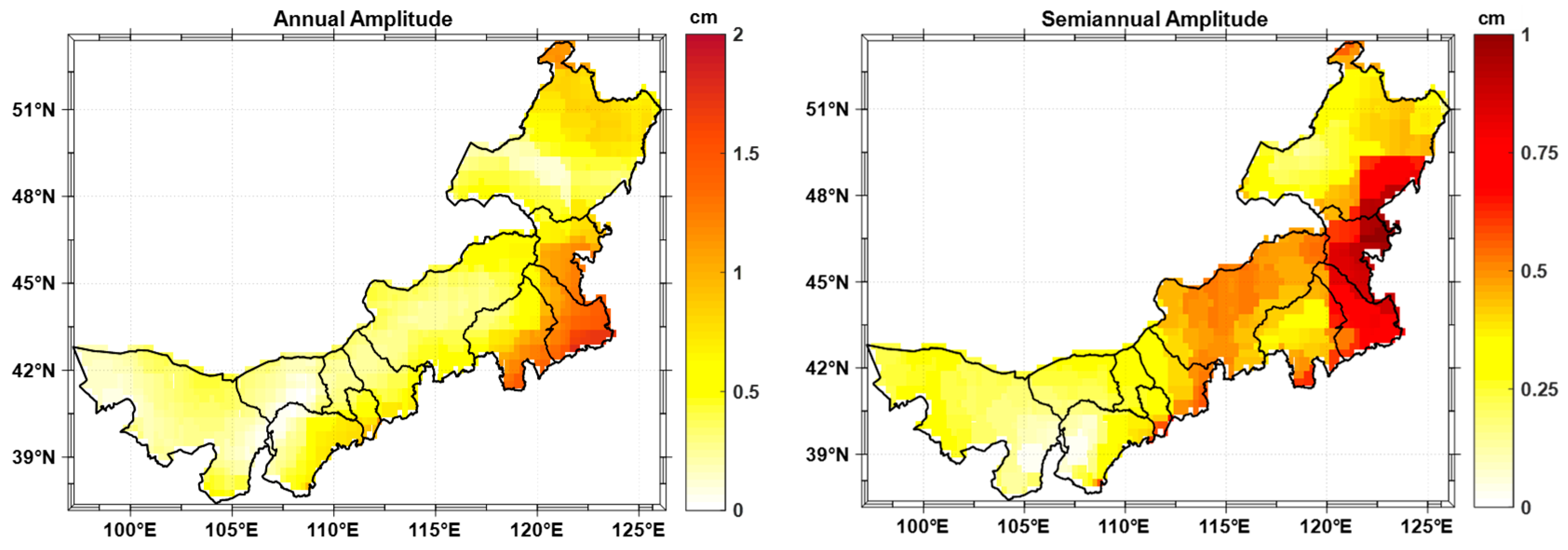
References
- Harder, P.; Pomeroy, J.W.; Westbrook, C.J. Hydrological resilience of a Canadian Rockies headwaters basin subject to changing climate, extreme weather, and forest management: Hydrological Resilience of a Canadian Rockies Basin Subject to Change. Hydrol. Process. 2015, 29, 3905–3924. [Google Scholar] [CrossRef]
- Ummenhofer, C.C.; Meehl, G.A. Extreme weather and climate events with ecological relevance: A review. Philos. Trans. R. Soc. B Biol. Sci. 2017, 372, 20160135. [Google Scholar] [CrossRef] [PubMed]
- Yang, D.; Yang, Y.; Xia, J. Hydrological cycle and water resources in a changing world: A review. Geogr. Sustain. 2021, 2, 115–122. [Google Scholar] [CrossRef]
- Humphrey, V.; Rodell, M.; Eicker, A. Using Satellite-Based Terrestrial Water Storage Data: A Review. Surv. Geophys. 2023, 44, 1489–1517. [Google Scholar] [CrossRef] [PubMed]
- Feng, W.; Zhong, M.; Lemoine, J.M.; Biancale, R.; Hsu, H.T.; Xia, J. Evaluation of groundwater depletion in North China using the gravity recovery and climate experiment (GRACE) data and ground-based measurements. Water Resour. Res. 2013, 49, 2110–2118. [Google Scholar] [CrossRef]
- Feng, T.; Shen, Y.; Chen, Q.; Wang, F.; Zhang, X. Groundwater storage change and driving factor analysis in north china using independent component decomposition. J. Hydrol. 2022, 609, 127708. [Google Scholar] [CrossRef]
- Chen, X.; Jiang, J.; Lei, T.; Yue, C. GRACE satellite monitoring and driving factors analysis of groundwater storage under high-intensity coal mining conditions: A case study of Ordos, northern Shaanxi and Shanxi, China. Hydrogeol. J. 2020, 28, 673–686. [Google Scholar] [CrossRef]
- Huan, C.; Wang, F.; Zhou, S.; Lu, T. Terrestrial water storage changes over 25 global river basins extracted by local mean decomposition from GRACE Monthly Gravity Field solutions. Acta Geodyn. Geomater. 2023, 19, 61–70. [Google Scholar] [CrossRef]
- Li, W.; Bao, L.; Yao, G.; Wang, F.; Guo, Q.; Zhu, J.; Zhu, J.; Wang, Z.; Bi, J.; Zhu, C.; et al. The analysis on groundwater storage variations from GRACE/GRACE-FO in recent 20 years driven by influencing factors and prediction in Shandong Province, China. Sci. Rep. 2024, 14, 5819. [Google Scholar] [CrossRef]
- Petch, S.; Dong, B.; Quaife, T.; King, R.P.; Haines, K. Precipitation explains GRACE water storage variability over large endorheic basins in the 21st century. Front. Environ. Sci. 2023, 11, 1228998. [Google Scholar] [CrossRef]
- Xie, X.; Xu, C.; Wen, Y.; Wei, L. Monitoring groundwater storage changes in the Loess Plateau using GRACE satellite gravity data, hydrological models and coal mining data. Remote Sens. 2018, 10, 605. [Google Scholar] [CrossRef]
- Liu, Z. Causes of changes in actual evapotranspiration and terrestrial water storage over the eurasian inland basins. Hydrol. Process. 2022, 36, e14482. [Google Scholar] [CrossRef]
- Long, D.; Xu, Y.; Cui, Y.; Cui, Y.; Butler, J.J., Jr.; Dong, L.; Wang, L.; Liu, D.; Wada, Y.; Hu, L.; et al. Unprecedented large-scale aquifer recovery through human intervention. Nat. Commun. 2025, 16, 7296. [Google Scholar] [CrossRef] [PubMed]
- Tapley, B.; Bettadpur, S.; Ries, J.; Thompson, P.; Watkins, M. GRACE measurements of mass variability in the Earth system. Science 2004, 305, 503–505. [Google Scholar] [CrossRef] [PubMed]
- Tapley, B.D.; Watkins, M.M.; Flechtner, F.; Reigber, C.; Bettadpur, S.; Rodell, M.; Sasgen, I.; Famiglietti, J.S.; Landerer, F.W.; Chambers, D.P.; et al. Contributions of GRACE to understanding climate change. Nat. Clim. Change 2019, 9, 358–369. [Google Scholar] [CrossRef] [PubMed]
- Wang, F.; Geng, J.; Shen, Y.; Wen, Y.; Feng, T. Regional Terrestrial Water Storage Changes in the Yangtze River Delta over the Recent 20 years. EGUsphere 2024, 202, 1–12. [Google Scholar] [CrossRef]
- Cho, Y. Analysis of terrestrial water storage variations in South Korea using GRACE satellite and GLDAS data in Google Earth Engine. Hydrol. Sci. J. 2024, 69, 1032–1045. [Google Scholar] [CrossRef]
- Rzepecka, Z.; Birylo, M.; Jarsjo, J.; Cao, F.; Pietroń, J. Groundwater Storage Variations across Climate Zones from Southern Poland to Arctic Sweden: Comparing GRACE-GLDAS Models with Well Data. Remote Sens. 2024, 16, 2104. [Google Scholar] [CrossRef]
- Zhou, T.; Wen, X.; Feng, Q.; Yu, H.; Xi, H. Bayesian Model Averaging Ensemble Approach for Multi-Time-Ahead Groundwater Level Prediction Combining the GRACE, GLEAM, and GLDAS Data in Arid Areas. Remote Sens. 2023, 15, 188. [Google Scholar] [CrossRef]
- Rana, S.K.; Chamoli, A. GRACE-derived groundwater variability and its resilience in north India: Impact of climatic and socioeconomic factors. Hydrol. Sci. J. 2024, 69, 2159–2171. [Google Scholar] [CrossRef]
- Shen, Y.; Zheng, W.; Zhu, H.; Yin, W.; Xu, A.; Pan, F.; Wang, Q.; Zhao, Y. Inverted Algorithm of Groundwater Storage Anomalies by Combining the GNSS, GRACE/GRACE-FO, and GLDAS: A Case Study in the North China Plain. Remote Sens. 2022, 14, 5683. [Google Scholar] [CrossRef]
- Yoshe, A.K. Water availability identification from GRACE dataset and GLDAS hydrological model over data-scarce river basins of Ethiopia. Hydrol. Sci. J. 2024, 69, 721–745. [Google Scholar] [CrossRef]
- Guo, Y.; Gan, F.; Yan, B.; Bai, J.; Xing, N.; Zhuo, Y. Evaluation of Terrestrial Water Storage Changes and Major Driving Factors Analysis in Inner Mongolia, China. Sensors 2022, 22, 9665. Available online: https://www.aminer.cn/pub/639738aa90e50fcafd8550a3 (accessed on 1 August 2025). [CrossRef] [PubMed]
- Guo, Y.; Xing, N.; Gan, F.; Yan, B.; Bai, J. Evaluating the Hydrological Components Contributions to Terrestrial Water Storage Changes in Inner Mongolia with Multiple Datasets. Sensors 2023, 23, 6452. Available online: https://www.aminer.cn/pub/64c5fc513fda6d7f0678d057 (accessed on 1 August 2025). [CrossRef] [PubMed]
- Wang, D.; Zhou, Y.; Wang, F. Decoupling Water Consumption from Economic Growth in Inner Mongolia, China. Water 2025, 17, 3073. [Google Scholar] [CrossRef]
- CMA Climate Change Centre. Blue Book on Climate Change in China; Science Press: Beijing, China, 2024. [Google Scholar]
- Save, H.; Bettadpur, S.; Tapley, B.D. High resolution CSR GRACE RL05 mascons. J. Geophys. Res. Solid Earth 2016, 121, 7547–7569. [Google Scholar] [CrossRef]
- Save, H. CSR GRACE and GRACE-FO RL06 Mascon Solutions v02; University of Texas at Austin: Austin, TX, USA, 2020. [Google Scholar] [CrossRef]
- Watkins, M.M.; Wiese, D.N.; Yuan, D.-N.; Boening, C.; Landerer, F.W. Improved methods for observing Earth’s time variable mass distribution with GRACE using spherical cap mascons. J. Geophys. Res. Solid Earth 2015, 120, 2648–2671. [Google Scholar] [CrossRef]
- Wiese, D.N.; Landerer, F.W.; Watkins, M.M. Quantifying and reducing leakage errors in the JPL RL05M GRACE mascon solution. Water Resour. Res. 2016, 52, 7490–7502. [Google Scholar] [CrossRef]
- Loomis, B.D.; Luthcke, S.B.; Sabaka, T.J. Regularization and error characterization of GRACE mascons. J. Geod. 2019, 93, 1381–1398. [Google Scholar] [CrossRef]
- Peltier, R.W.; Argus, D.F.; Drummond, R. Comment on “an assessment of the ICE-6G_C (VM5a) glacial isostatic adjustment model” by Purcell et al. J. Geophys. Res. Solid Earth 2018, 123, 2019–2028. [Google Scholar] [CrossRef]
- Landerer, F.W.; Flechtner, F.M.; Save, H.; Webb, F.H.; Bandikova, T.; Bertiger, W.I.; Bettadpur, S.V.; Byun, S.H.; Dahle, C.; Dobslaw, H.; et al. Extending the global mass change data record: GRACE Follow-On in-strument and science data performance. Geophys. Res. Lett. 2020, 47, e2020GL088306. [Google Scholar] [CrossRef]
- Landerer, F. Monthly Estimates of Degree-1 (Geocenter) Gravity Coefficients, Generated from GRACE (04-2002-06/2017) and GRACE-FO (06/2018 Onward) RL06 Solutions, GRACE Technical Note 13, The GRACE Project, NASA Jet Propulsion Laboratory. 2019. Available online: https://podaac-tools.jpl.nasa.gov/drive/files/allData/grace/docs (accessed on 1 August 2025).
- Beaudoing, H.; Rodell, M. NASA/GSFC/HSL 2020 GLDAS Noah Land Surface Model L4 monthly 1.0 × 1.0 degree V2.1, Greenbelt, Maryland, USA, Goddard Earth Sciences Data and Information Services Center (GES DISC). Available online: https://disc.gsfc.nasa.gov/datasets/GLDAS_NOAH10_M_2.1/summary (accessed on 4 April 2024).
- Li, B.; Beaudoing, H.; Rodell, M. NASA/GSFC/HSL 2020, GLDAS Catchment Land Surface Model L4 monthly 1.0 × 1.0 degree V2.1, Greenbelt, Maryland, USA, Goddard Earth Sciences Data and Information Services Center (GES DISC). Available online: https://disc.gsfc.nasa.gov/datasets/GLDAS_CLSM10_M_2.1/summary (accessed on 1 August 2025).
- Beaudoing, H.; Rodell, M. NASA/GSFC/HSL 2020, GLDAS VIC Land Surface Model L4 monthly 1.0 × 1.0 degree V2.1, Greenbelt, Maryland, USA, Goddard Earth Sciences Data and Information Services Center (GES DISC). Available online: https://disc.gsfc.nasa.gov/datasets/GLDAS_VIC10_M_2.1/summary (accessed on 1 August 2025).
- Rodell, M.; Houser, P.R.; Jambor, U.; Gottschalck, J.; Mitchell, K.; Meng, C.; Arsenault, K.; Cosgrove, B.; Radakovich, J.; Bosilovich, M.; et al. The Global Land Data Assimilation System. Bull. Am. Meteorol. Soc. 2004, 85, 381–394. [Google Scholar] [CrossRef]
- Feng, W.; Shum, C.K.; Zhong, M.; Pan, Y. Groundwater storage changes in China from satellite gravity: An overview. Remote Sens. 2018, 10, 674. [Google Scholar] [CrossRef]
- Yuan, X.; Zhou, Y.; Zhou, S.; Wang, F. Agricultural and energy sectors dominate Iran’s water crisis: A GRACE-GLDAS quantification (2002–2023). Acta Geodyn. Geomater. 2025, 22, 393–404. [Google Scholar] [CrossRef]
- Wang, F.; Zhou, Q.; Gao, H.; Wen, Y.; Zhou, S. Dynamic Monitoring of Poyang Lake Water Area and Storage Changes from 2002 to 2022 via Remote Sensing and Satellite Gravimetry Techniques. Remote Sens. 2024, 16, 2408. [Google Scholar] [CrossRef]
- Ding, Z. Groundwater Levels Continue to Rise in Ordos, Inner Mongolia. People’s Daily. 2025. Available online: https://slt.nmg.gov.cn/mobile/sldt_14620/mtzs_14629/202504/t20250409_2700124.html (accessed on 1 August 2025).
- Shangdu County People’s Government. Shangdu County: Bolsters Water Conservation Efforts, Groundwater Levels Rise Steadily. 2025. Available online: https://www.wulanchabu.gov.cn/qxdt/1721959.html (accessed on 1 August 2025).
- En, H.; Lian, Z. Chuo’er River and West Liao River Linked Up in 400-km Water Project After 2500 Days. 2025. Available online: https://www.nmg.gov.cn/zwyw/ymjnmg/202507/t20250709_2755885.html (accessed on 1 August 2025).
- Li, J. Chifeng City’s Hongshan District in Inner Mongolia Comprehensively Strengthens Groundwater Conservation through Extraction Control. 2025. Available online: https://slt.nmg.gov.cn/mobile/sldt_14620/msdt_14628/202501/t20250110_2651330.html (accessed on 1 August 2025).
- Su, N. Xilin Gol Grassland Restoration Breakthrough: From Desertification to Oasis in a Decade. 2025. Available online: https://baijiahao.baidu.com/s?id=1833384368955693330&wfr=spider&for=pc (accessed on 1 August 2025).
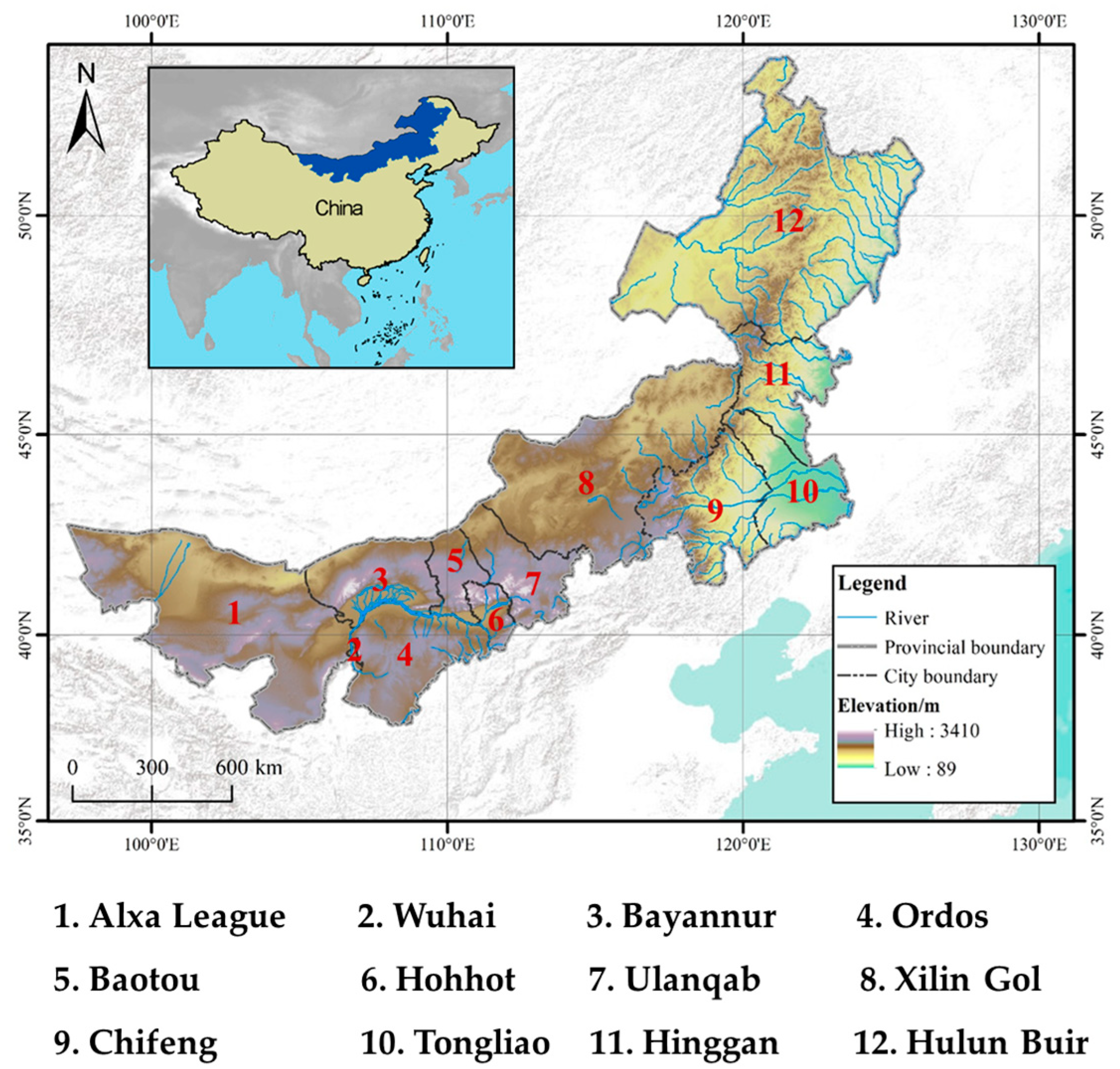

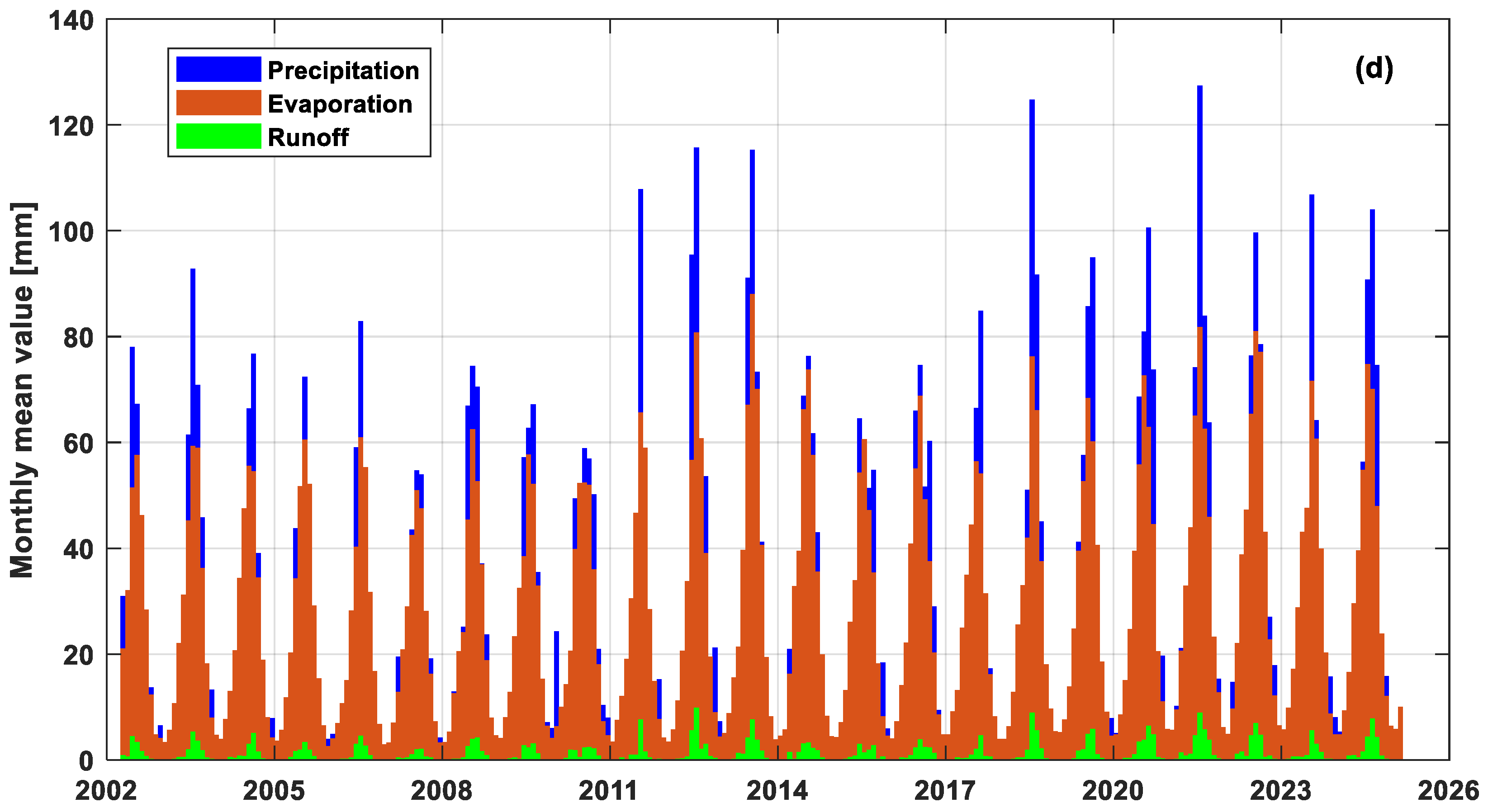
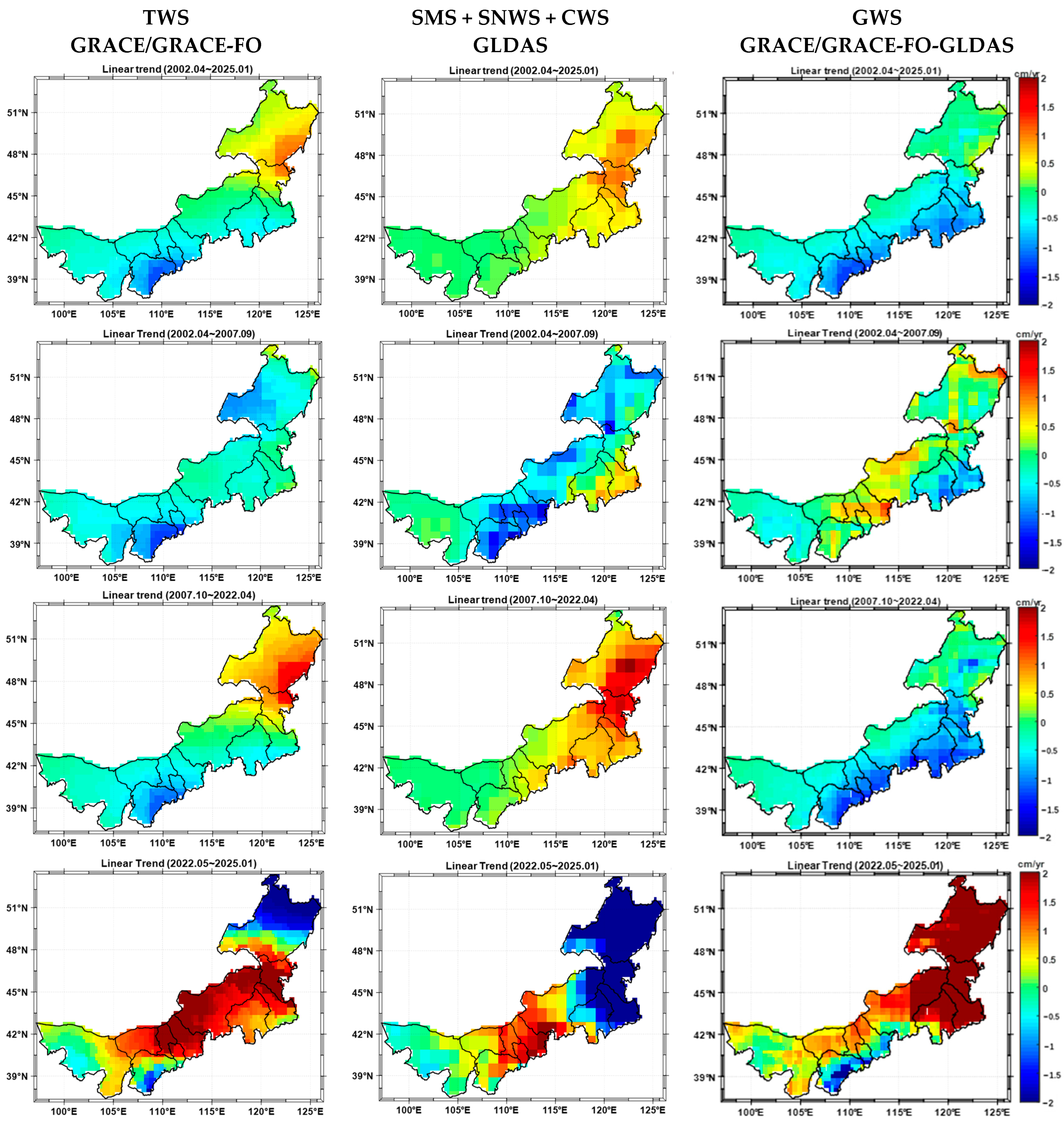

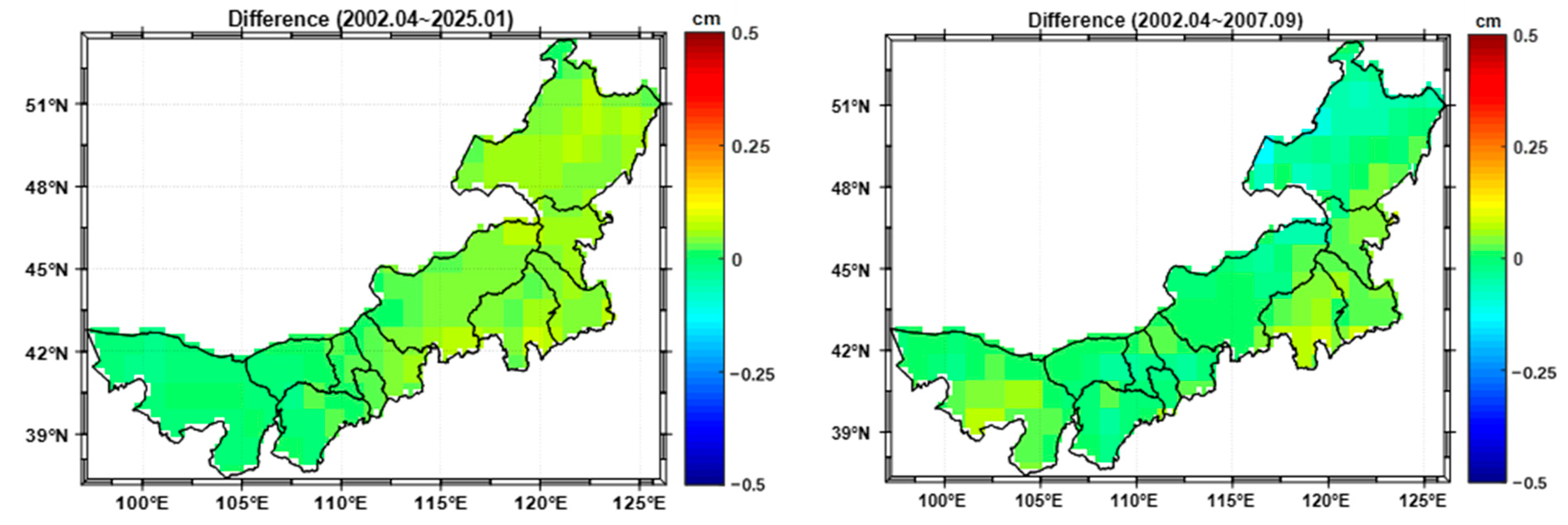


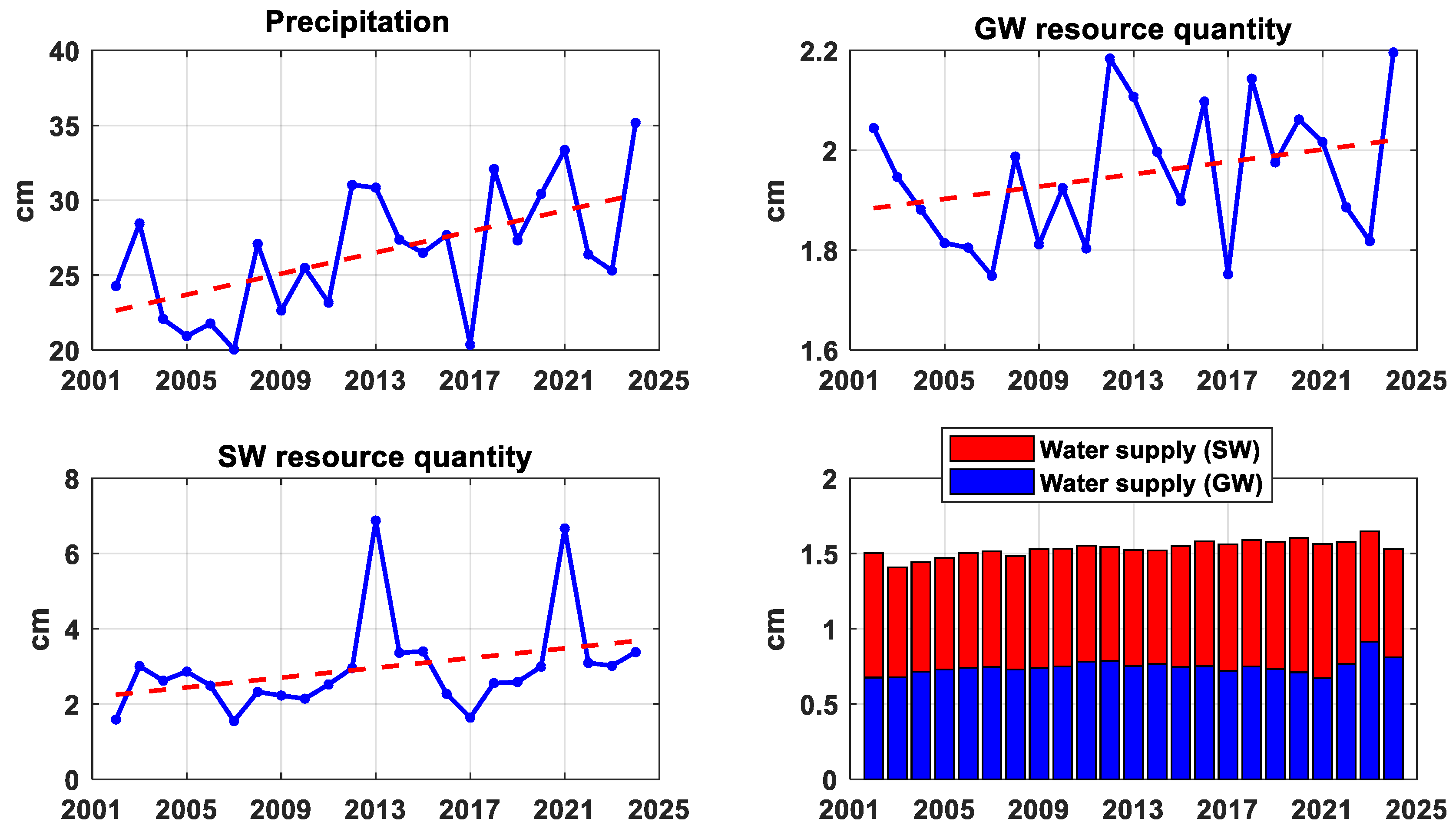
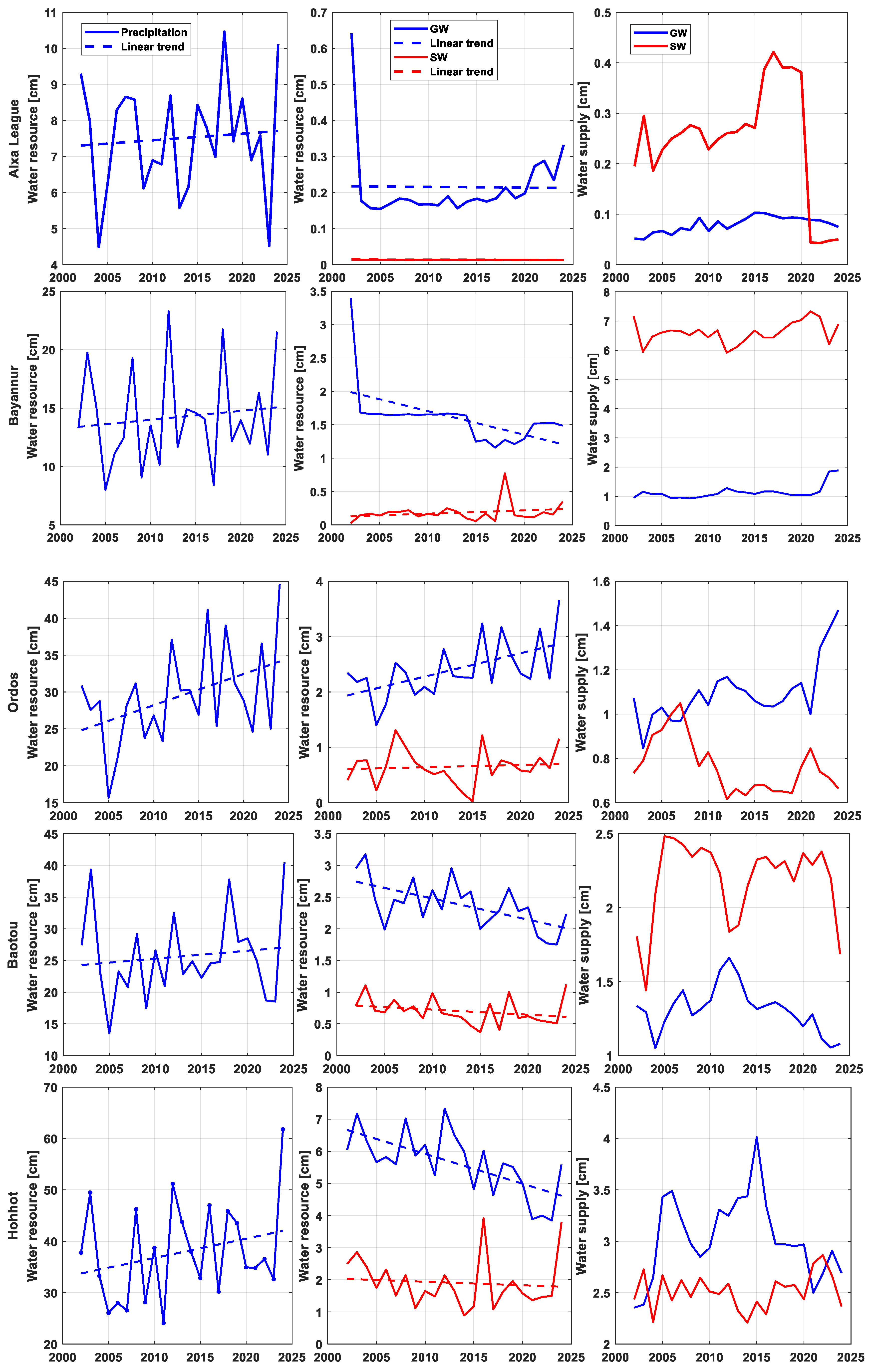



| Type | Index | Annual Amplitude [mm] Phase [deg] | Semiannual Amplitude [mm] Phase [deg] | Linear Trend [mm/year] |
|---|---|---|---|---|
| TWS GRACE/GRACE-FO | CSR | [2.03 ± 1.52] [286.7 ± 42.4] | [2.74 ± 1.52] [95.3 ± 31.6] | −1.49 ± 0.16 |
| JPL | [4.18 ± 1.76] [237.4 ± 24.4] | [3.39 ± 1.76] [100.3 ± 29.9] | −1.09 ± 0.18 | |
| GSFC | [0.93 ± 1.78] [287.0 ± 109.2] | [4.04 ± 1.78] [117.3 ± 25.3] | −2.49 ± 0.18 | |
| Average | [2.17 ± 1.63] [257.6 ± 42.7] | [3.34 ± 1.62] [105.7 ± 27.9] | −1.69 ± 0.17 | |
| SMS + SNWS + CWS GLDAS | CLSM | [9.17 ± 1.48] [7.2 ± 9.3] | [3.15 ± 1.48] [103.7 ± 27.1] | 3.86 ± 0.15 |
| NOAH | [5.01 ± 1.72] [299.7 ± 19.7] | [2.34 ± 1.72] [127.8 ± 45.6] | 2.79 ± 0.18 | |
| VIC | [7.18 ± 1.57] [110.2 ± 12.5] | [1.01 ± 1.57] [298.8 ± 89.4] | 2.80 ± 0.16 | |
| Average | [3.26 ± 1.52] [21.3 ± 26.8] | [1.45 ± 1.52] [112.8 ± 60.1] | 3.15 ± 0.16 | |
| GWS | GRACE/GRACE-FO − GLDAS (Average) | [4.81 ± 1.21] [223.3 ± 7.3] | [1.91 ± 1.21] [100.3 ± 36.4] | −4.84 ± 0.12 |
| Type | Index | Annual Amplitude [mm] Phase [deg] | Semiannual Amplitude [mm] Phase [deg] | Linear Trend [mm/year] |
|---|---|---|---|---|
| Alxa League | TWS (GRACE/GRACE-FO) | [1.81 ± 0.88] [207.0 ± 27.9] | [1.86 ± 0.86] [85.3 ± 27.3] | −3.86 ± 0.09 |
| SMS+SNWS+CWS (GLDAS) | [2.50 ± 0.40] [296.1 ± 9.2] | [1.27 ± 0.40] [157.3 ± 18.1] | 0.09 ± 0.04 | |
| GWS (GRACE/GRACE-FO−GLDAS) | [3.06 ± 0.80] [152.3 ± 15.1] | [1.90 ± 0.81] [45.8 ± 42.9] | −3.95 ± 0.08 | |
| Bayannur | TWS (GRACE/GRACE-FO) | [1.10 ± 1.25] [217.5 ± 62.5] | [2.15 ± 1.25] [76.6 ± 33.4] | −4.80 ± 0.13 |
| SMS+SNWS+CWS (GLDAS) | [4.66 ± 1.06] [316.2 ± 5.1] | [2.19 ± 1.07] [176.4 ± 27.8] | 0.03 ± 0.11 | |
| GWS (GRACE/GRACE-FO−GLDAS) | [4.94 ± 1.09] [148.9 ± 12.7] | [3.32 ± 1.10] [36.0 ± 18.5] | −4.83 ± 0.11 | |
| Ordos | TWS (GRACE/GRACE-FO) | [4.82 ± 1.87] [1.8 ± 22.4] | [2.15 ± 1.88] [169.4 ± 49.9] | −9.57 ± 0.19 |
| SMS+SNWS+CWS (GLDAS) | [9.79 ± 1.58] [315.7 ± 2.4] | [4.68 ± 1.58] [178.2 ± 19.3] | 0.63 ± 0.16 | |
| GWS (GRACE/GRACE-FO−GLDAS) | [7.33 ± 1.84] [107.5 ± 14.3] | [2.58 ± 1.85] [5.4 ± 40.8] | −10.20 ± 0.19 | |
| Baotou | TWS (GRACE/GRACE-FO) | [2.74 ± 1.63] [321.5 ± 31.8] | [2.70 ± 1.63] [110.3 ± 34.7] | −5.88 ± 0.17 |
| SMS+SNWS+CWS (GLDAS) | [7.92 ± 1.76] [324.3 ± 12.5] | [3.34 ± 1.77] [169.4 ± 30.1] | 0.76 ± 0.18 | |
| GWS (GRACE/GRACE-FO−GLDAS) | [5.18 ± 1.55] [145.7 ± 17.0] | [3.03 ± 1.55] [39.2 ± 26.8] | −6.64 ± 0.16 | |
| Hohhot | TWS (GRACE/GRACE-FO) | [6.42 ± 1.89] [341.6 ± 17.0] | [3.98 ± 1.90] [142.9 ± 26.4] | −8.55 ± 0.20 |
| SMS+SNWS+CWS (GLDAS) | [8.29 ± 2.33] [349.7 ± 16.2] | [4.67 ± 2.34] [191.7 ± 28.6] | 1.30 ± 0.24 | |
| GWS (GRACE/GRACE-FO−GLDAS) | [2.13 ± 2.08] [194.7 ± 56.5] | [3.62 ± 2.09] [67.3 ± 33.1] | −9.85 ± 0.22 | |
| Ulanqab | TWS (GRACE/GRACE-FO) | [4.22 ± 1.64] 327.5 ± 22.3] | [4.14 ± 1.64] [112.9 ± 22.8] | −5.20 ± 0.17 |
| SMS+SNWS+CWS (GLDAS) | [5.62 ± 2.24] [333.5 ± 22.9] | [2.21 ± 2.25] [213.1 ± 58.0] | 2.24 ± 0.23 | |
| GWS (GRACE/GRACE-FO−GLDAS) | [1.50 ± 1.96] [170.6 ± 75.5] | [5.03 ± 1.96] [87.3 ± 22.4] | −7.44 ± 0.20 | |
| Xilin Gol | TWS (GRACE/GRACE-FO) | [3.37 ± 1.87] [283.6 ± 31.6] | [4.62 ± 1.86] [88.9 ± 23.2] | −1.29 ± 0.19 |
| SMS+SNWS+CWS (GLDAS) | [2.13 ± 2.00] [346.8 ± 54.1] | [1.33 ± 2.00] [64.9 ± 86.4] | 3.45 ± 0.21 | |
| GWS (GRACE/GRACE-FO−GLDAS) | [3.07 ± 1.57] [245.3 ± 29.2] | [3.44 ± 1.56] [98.0 ± 26.1] | −4.74 ± 0.16 | |
| Chifeng | TWS (GRACE/GRACE-FO) | [8.29 ± 3.10] [266.8 ± 21.3] | [4.33 ± 3.09] [102.8 ± 41.0] | −4.11 ± 0.32 |
| SMS+SNWS+CWS (GLDAS) | [12.60 ± 2.99] [259.9 ± 13.5] | [5.88 ± 2.98] [82.6 ± 29.1] | 4.40 ± 0.31 | |
| GWS (GRACE/GRACE-FO−GLDAS) | [4.46 ± 2.13] [67.1 ± 27.2] | [2.35 ± 2.13] [223.2 ± 27.5] | −8.51 ± 0.22 | |
| Tongliao | TWS (GRACE/GRACE-FO) | [13.30 ± 3.78] [249.0 ± 16.1] | [7.094 ± 3.76] [96.1 ± 30.5] | −2.58 ± 0.39 |
| SMS+SNWS+CWS (GLDAS) | [11.30 ± 3.42] [259.2 ± 17.2] | [7.33 ± 3.40] [82.9 ± 26.7] | 5.69 ± 0.35 | |
| GWS (GRACE/GRACE-FO−GLDAS) | [2.97 ± 2.47] [206.2 ± 47.9] | [1.68 ± 2.48] [187.4 ± 84.5] | −8.27 ± 0.26 | |
| Hinggan | TWS (GRACE/GRACE-FO) | [9.55 ± 3.93] [244.3 ± 23.5] | [8.25 ± 3.91] [91.4 ± 27.3] | 5.05 ± 0.41 |
| SMS+SNWS+CWS (GLDAS) | [4.49 ± 4.28] [290.5 ± 54.4] | [4.82 ± 4.26] [104.6 ± 50.9] | 9.12 ± 0.44 | |
| GWS (GRACE/GRACE-FO−GLDAS) | [7.22 ± 2.88] [217.6 ± 21.9] | [3.72 ± 2.88] [74.2 ± 44.5] | −4.07 ± 0.30 | |
| Hulun Buir | TWS (GRACE/GRACE-FO) | [3.01 ± 3.56] [129.7 ± 78.2] | [3.46 ± 3.56] [136.0 ± 19.5] | 5.09 ± 3.69 |
| SMS+SNWS+CWS (GLDAS) | [11.30 ± 4.03] [51.2 ± 22.8] | [2.84 ± 4.04] [171.3 ± 81.0] | 6.10 ± 0.42 | |
| GWS (GRACE/GRACE-FO−GLDAS) | [11.10 ± 1.88] [215.7 ± 9.6] | [2.00 ± 1.88] [80.6 ± 54.1] | −1.01 ± 0.20 |
| Type | TWS | GWS | Water Resource 2002–2024 | Water Use 2022–2024 |
|---|---|---|---|---|
| Alxa | ↓2002.4–2025.1 | ↓2002.4–2025.1 | P↑; SW−; GW↓ | SW↓; GW↓ |
| Bayannur | ↓2002.4–2025.1 | ↓2002.4–2025.1 | P↑; SW↑; GW↓ | SW−; GW↑ |
| Ordos | ↓2002.4–2025.1 | ↓2002.4–2025.1 | P↑; SW↑; GW↑ | SW↓; GW↑ |
| Baotou | ↓2002.4–2025.1 | ↓2002.4–2025.1 | P↑; SW↓; GW↓ | SW↓; GW↓ |
| Hohhot | ↓2002.4–2025.1 | ↓2002.4–2025.1 | P↑; SW↓; GW↓ | SW↓; GW↑ |
| Ulanqab | ↓2002.4–2025.1 | ↓2002.4–2022.4 ↑2022.5–2025.1 | P↑; SW↓; GW↑ | SW↑; GW− |
| Xilin Gol | ↓2002.4–2025.1 | ↓2002.4–2022.4 ↑2022.5–2025.1 | P↑; SW↑; GW↑ | SW−; GW↑ |
| Chifeng | ↓2002.4–2025.1 | ↓2002.4–2022.4 ↑2022.5–2025.1 | P↑; SW↑; GW↓ | SW↑; GW↓ |
| Tongliao | ↓2002.4–2025.1 | ↓2002.4–2022.4 ↑2022.5–2025.1 | P↑; SW↑; GW↑ | SW−; GW− |
| Hinggan | ↑2002.4–2025.1 | ↓2002.4–2022.4 ↑2022.5–2025.1 | P↑; SW↑; GW↓ | SW↑; GW↓ |
| Hulun Buir | ↑2002.4–2025.1 | ↓2002.4–2022.4 ↑2022.5–2025.1 | P↑; SW↑; GW− | SW↓; GW− |
Disclaimer/Publisher’s Note: The statements, opinions and data contained in all publications are solely those of the individual author(s) and contributor(s) and not of MDPI and/or the editor(s). MDPI and/or the editor(s) disclaim responsibility for any injury to people or property resulting from any ideas, methods, instructions or products referred to in the content. |
© 2025 by the authors. Licensee MDPI, Basel, Switzerland. This article is an open access article distributed under the terms and conditions of the Creative Commons Attribution (CC BY) license (https://creativecommons.org/licenses/by/4.0/).
Share and Cite
Zhang, D.; Peng, J.; Wang, F.; Feng, T.; Tian, Y.; Gao, R.; Ma, L. From Depletion to Recovery: Tracking Water Storage Changes in the Semiarid Region of Inner Mongolia, China. Remote Sens. 2025, 17, 3668. https://doi.org/10.3390/rs17223668
Zhang D, Peng J, Wang F, Feng T, Tian Y, Gao R, Ma L. From Depletion to Recovery: Tracking Water Storage Changes in the Semiarid Region of Inner Mongolia, China. Remote Sensing. 2025; 17(22):3668. https://doi.org/10.3390/rs17223668
Chicago/Turabian StyleZhang, Donghua, Junhuan Peng, Fengwei Wang, Tengfei Feng, Yanan Tian, Ruizhong Gao, and Long Ma. 2025. "From Depletion to Recovery: Tracking Water Storage Changes in the Semiarid Region of Inner Mongolia, China" Remote Sensing 17, no. 22: 3668. https://doi.org/10.3390/rs17223668
APA StyleZhang, D., Peng, J., Wang, F., Feng, T., Tian, Y., Gao, R., & Ma, L. (2025). From Depletion to Recovery: Tracking Water Storage Changes in the Semiarid Region of Inner Mongolia, China. Remote Sensing, 17(22), 3668. https://doi.org/10.3390/rs17223668






